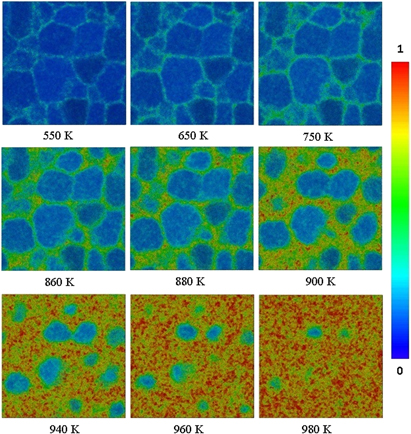Crossref Citations
This article has been cited by the following publications. This list is generated based on data provided by
Crossref.
Ma, Shenggui
Li, Shichang
Gao, Tao
Shen, Yanhong
Chen, Xiaojun
Xiao, Chengjian
and
Lu, Tiecheng
2018.
Molecular dynamics simulations of structural and melting properties of Li2SiO3.
Ceramics International,
Vol. 44,
Issue. 3,
p.
3381.
Pachauri, U.
Joshi, D. P.
and
Arora, N.
2019.
Superheating of free-standing nanometals under pressure.
EPL (Europhysics Letters),
Vol. 126,
Issue. 2,
p.
26001.
Liu, Jialin
Fan, Xiaofeng
Shi, Yunfeng
Singh, David J.
and
Zheng, Weitao
2019.
Melting of Nanocrystalline Gold.
The Journal of Physical Chemistry C,
Vol. 123,
Issue. 1,
p.
907.
Alizadeh, Javad
Salati, Amin
Ebrahimi Fordoei, Mohammad Reza
and
Panjepour, Masoud
2021.
Investigation of Grain Boundary Influence on the Thermodynamic Phase Stability of Nanocrystalline Iron by Using the Molecular Dynamics Simulation Method.
Journal of Materials Engineering and Performance,
Vol. 30,
Issue. 6,
p.
4681.
Keramat, Ehsan
and
Hashemi, Babak
2021.
Modelling and optimizing the liquid phase sintering of alumina/CaO–SiO2–Al2O3 ceramics using response surface methodology.
Ceramics International,
Vol. 47,
Issue. 3,
p.
3159.
Ju, Shin-Pon
Li, Chen-Chun
and
Shih, Huai-Ting
2022.
How atoms of polycrystalline Nb20.6Mo21.7Ta15.6W21.1V21.0 refractory high-entropy alloys rearrange during the melting process.
Scientific Reports,
Vol. 12,
Issue. 1,
Guo, Fumin
Wang, Jian
Li, Yu
Yu, Shanshan
Xu, Xiuwen
Cai, Xin
Fang, Yueping
Vayssieres, Lionel
Saidaminov, Makhsud I.
and
Yang, Shihe
2022.
Postripening Fabrication and Self‐Driven Narrowband Photoresponse of Large‐Grain, Phase‐Pure CsPbBr3 Films.
Solar RRL,
Vol. 6,
Issue. 12,
El-Masry, Mai M.
and
Ibrahim, Amin S.
2022.
Ag-CuO/rGO/PVDF nanocomposite synthesized via simple method as a broadband non-linear optical material for optronic applications.
Journal of Materials Science: Materials in Electronics,
Vol. 33,
Issue. 14,
p.
10851.
Yang, Zhenze
and
Buehler, Markus J.
2022.
Linking atomic structural defects to mesoscale properties in crystalline solids using graph neural networks.
npj Computational Materials,
Vol. 8,
Issue. 1,
Rincent, Camille
Castillo-Sánchez, Juan-Ricardo
Gheribi, Aïmen E.
and
Harvey, Jean-Philippe
2023.
On the exploration of the melting behavior of metallic compounds and solid solutions via multiple classical molecular dynamics approaches: application to Al-based systems.
Physical Chemistry Chemical Physics,
Vol. 25,
Issue. 15,
p.
10866.
Gao, Tinghong
Liu, Lulu
Li, Lianxin
Zhang, Zhan
Tian, Zean
Liang, Yongchao
and
Peng, Yikun
2023.
Aggregation behavior and structural properties of Ti3Al nanoparticles.
MRS Communications,
Vol. 13,
Issue. 6,
p.
1388.
Zhao, Hong
Zheng, Zhong
Zhou, Haoruo
Chang, Li
Tsoutas, Kostadinos
Yang, Limei
Alavi, Seyedeh KH
Liu, Yanping
Akhavan, Behnam
Bilek, Marcela M
and
Liu, Zongwen
2023.
Cathodic arc deposition of high entropy alloy thin films with controllable microstructure.
Surfaces and Interfaces,
Vol. 37,
Issue. ,
p.
102692.
Vlasova, Marina
Márquez Aguilar, Pedro Antonio
Hernández Morelos, Jorge Luis
Parra Parra, Abigail
Guardián Tapia, Rene
and
Reséndiz González, Marycruz
2023.
Obtaining Electroheating Elements Based on Products of Carbothermal Reduction of Fe2O3 by Waste Activated Sludge (WAS).
Waste and Biomass Valorization,
Vol. 14,
Issue. 4,
p.
1319.
Barbot, Armand
and
Gatti, Riccardo
2023.
Unsupervised learning for structure detection in plastically deformed crystals.
Computational Materials Science,
Vol. 230,
Issue. ,
p.
112459.
Shokri, Jaber
Alizadeh, Javad
Panjepour, Masoud
and
Meratian, Mahmood
2024.
Exploring mass transfer mechanisms in sintering processes through molecular dynamics simulation.
Materials Today Communications,
Vol. 38,
Issue. ,
p.
108048.
Singh, Mahendra
Murugan, Natarajan Arul
Kongsted, Jacob
Zhan, Peng
Banerjee, Uttam Chand
and
Poongavanam, Vasanthanathan
2024.
Molecular Insights from Spectral and Computational Studies on Crystalline and Amorphous Telmisartan.
Crystal Growth & Design,
Vol. 24,
Issue. 15,
p.
6354.
Khoei, A.R.
Orvati Movaffagh, A.M.
and
Rezaei Sameti, A.
2024.
Thermo-mechanical characteristics of oxide-coated aluminum nano-powder.
International Journal of Thermal Sciences,
Vol. 197,
Issue. ,
p.
108767.
Zhang, Jianyue
Li, Jianxiong
Miao, Jiashi
Mao, Yu
Huang, Xuejun
Vivek, Anupam
Daehn, Glenn
and
Luo, Alan A.
2024.
Increasing joint strength in magnesium-aluminum dissimilar impact welding by surface nanocrystallization of magnesium alloy sheet.
Scripta Materialia,
Vol. 251,
Issue. ,
p.
116190.
Poletaev, Gennady
Rakitin, Roman
Bebikhov, Yuriy
and
Semenov, Alexander
2025.
Molecular dynamics study of melting initiation at tilt grain boundaries depending on their misorientation angle in aluminum.
Physica Scripta,
Vol. 100,
Issue. 1,
p.
015988.
Poletaev, Gennady M.
Rakitin, Roman Y.
and
Zorya, Irina V.
2025.
Molecular dynamics study of the dissolution of crystalline and amorphous nickel nanoparticles in aluminium.
International Journal of Materials Research,
Vol. 116,
Issue. 2,
p.
123.



